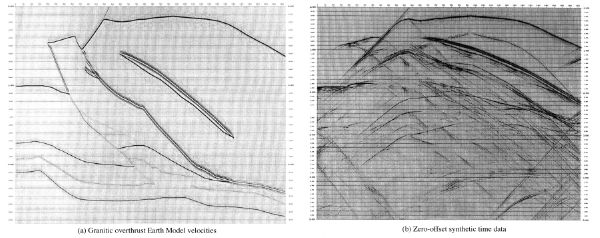Granitic Overthrust
Figure 11 shows a granitic overthrust model from the Northern United States together with a simulation of a zero-offset section using that model. The problem is to unravel this data and put it back in its proper location. The objective are the sediments below the granite thrust.
Granitic overthrusts are certainly as difficult to image as salt structures. Granitic structures are representative of structures with velocity contrasts between 3 and 3.6 to 1, where granite velocities are usually between 6800 and 7000 m/s, while near surface velocities are in the neighborhood of 1800 m/s.
Imaging the top and base of such structures with a time migration is almost impossible.
Figure 12 shows that a comparison of phase shift migration with reverse time migration is in reality no comparison at all. A single velocity function simply cannot cope with the extreme variation in the actual Earth model.
Figure
13 shows that an FK migration is no better than the phase shift of the previous figure.
In contrast to the previous methods, the cascade migration shown in Figure 14 does a superior job of imaging above and to the left of the granitic intrusion, but simply cannot image anything below the granitic overthrust accurately.




